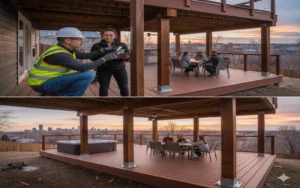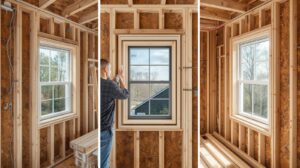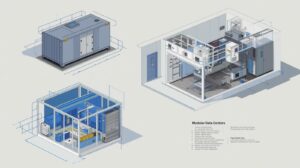Signs of Structural Problems: A Homeowner’s Guide to Identifying Serious Issues
As a structural engineer with over 15 years of experience evaluating homes across Denver, I’ve seen how small, overlooked signs of structural problems can evolve into major safety concerns and costly repairs. Many homeowners dismiss early warning signs as normal “settling,” but understanding the difference between cosmetic issues and serious structural damage symptoms could save you tens of thousands of dollars and ensure your family’s safety.
Your home is more than just a living space—it’s a complex structural system where foundation, walls, floors, and roof work together to provide shelter and security. When one component fails, it can compromise the entire structure. This comprehensive guide will help you recognize the structural issues indicators that demand professional attention, potentially saving you from catastrophic failure and preserving your property’s value.
What Are Structural Problems and Why Should You Care?
Structural problems refer to issues that affect the integrity of your home’s load-bearing components—the foundation, walls, beams, and columns that keep your home standing. Unlike cosmetic flaws, these problems can compromise your home’s safety and lead to expensive repairs if left unaddressed.
In Denver’s unique environment, where soil conditions and weather patterns create specific challenges, understanding signs of structural problems becomes even more critical. The clay-rich soil common throughout our region expands and contracts with moisture changes, putting constant pressure on foundations. This makes regular monitoring and early detection essential for Colorado homeowners.
The Most Common Signs of Structural Damage
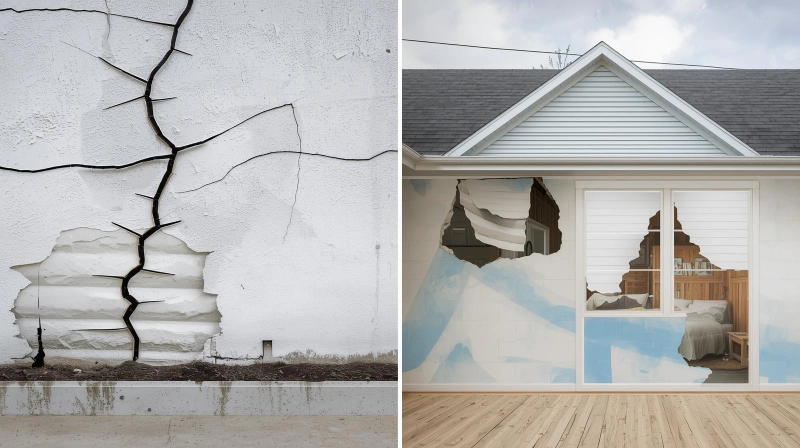
1. Cracks in Walls and Foundations
Not all cracks indicate serious issues, but understanding their patterns and locations helps identify potential structural damage symptoms.
Hairline cracks (less than 1/8 inch wide) in drywall are typically normal settling, especially in newer homes. However, you should be concerned about:
- Stair-step cracks in brick or masonry walls
- Horizontal cracks in foundation walls (often indicating soil pressure)
- Vertical cracks that widen at top or bottom
- Cracks wider than 1/4 inch anywhere in the structure
- Cracks that reappear after repair
The pattern, direction, and width of cracks provide crucial clues about their cause and severity. Our detailed guide on Denver home foundation issues explains how local soil conditions contribute to specific cracking patterns.
2. Doors and Windows That Stick or Won’t Close Properly
When doors and windows sticking becomes a structural problem rather than a humidity issue:
- Multiple doors/windows throughout house are affected simultaneously
- Problems develop progressively worse over time
- Gaps appear around frames while doors/windows won’t close
- Operation was smooth initially but has deteriorated
This often indicates frame distortion caused by foundation movement or structural shifting, requiring professional assessment through our Residential Structural Engineering Services in Denver.
3. Uneven or Sloping Floors
While some floor slope is common in older homes, significant sloping:
- Exceeds 1 inch over 20 feet
- Is accompanied by other warning signs
- Is progressively worsening
- Creates visible gaps between floors and walls
Use a marble or level to test floor slopes, and document changes over time.
4. Gaps Between Walls, Ceilings, and Floors
Separation appearing where walls meet ceilings or floors often indicates structural movement or foundation settlement that requires professional evaluation.
5. Sagging or Uneven Roof Lines
Visible sagging in rooflines, especially when viewed from a distance, may indicate:
- Rafter or truss problems
- Foundation issues affecting the entire structure
- Overloading from snow accumulation or improper modifications
Table: Structural Problem Severity Guide
| Sign | Minor Concern | Moderate Concern | Serious Concern |
| Crack Width | <1/8″ | 1/8″ – 1/4″ | >1/4″ |
| Floor Slope | <1″ over 20′ | 1″-2″ over 20′ | >2″ over 20′ |
| Door Operation | Single door sticks | Multiple doors stick | Doors won’t latch |
| Window Operation | Seasonal sticking | Consistent sticking | Frame separation |
Less Obvious Signs of Structural Issues
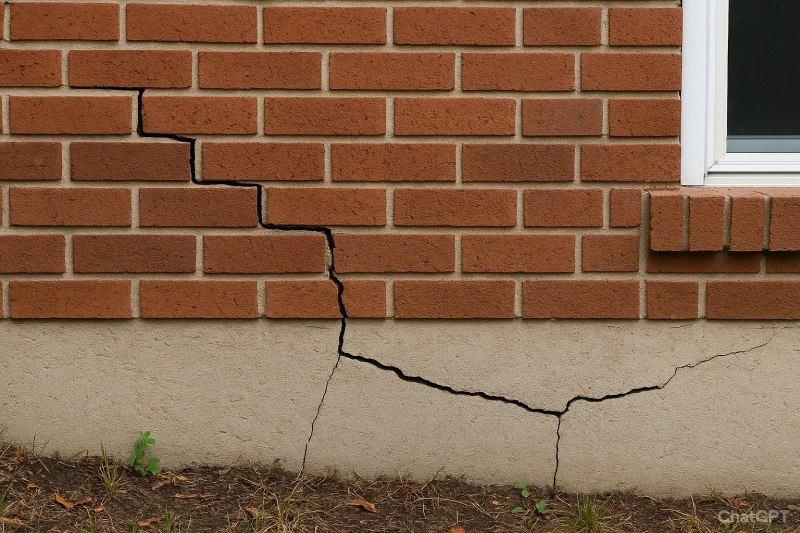
6. Moisture Intrusion and Water Damage
Chronic moisture problems can indicate and cause structural issues:
- Basement wall leaks that suggest foundation cracks
- Rotting wood in structural members
- Mold growth indicating persistent moisture
- Efflorescence (white powder) on masonry, suggesting water movement through walls
7. Bouncing or Sagging Floors
Excessive floor movement under normal foot traffic may indicate:
- Undersized floor joists
- Rot or insect damage to structural wood
- Improper modifications during renovations
8. Chimney Tilting or Separation
Chimneys pulling away from the house or developing visible lean often indicate foundation movement or inadequate support.
When to Worry: Red Flags That Demand Immediate Attention
Some signs of structural problems require immediate professional intervention:
- Rapidly worsening cracks (widening more than 1/8 inch per month)
- Horizontal foundation cracks (especially if accompanied by bowing)
- Doors/windows that no longer latch due to frame distortion
- Visible foundation movement (cracks that open and close with seasons)
- Significant water intrusion in basement or crawl spaces
If you observe any of these red flags, contact a structural engineer immediately. Early intervention through our Residential Structural Engineering Services in Denver can prevent more extensive damage.
DIY Assessment vs. Professional Evaluation
While homeowners can monitor for structural issues indicators, professional assessment is crucial for accurate diagnosis. Here’s how to approach both:
Homeowner Monitoring
- Document cracks with dates and measurements
- Take photographs every 3-6 months for comparison
- Monitor door and window operation
- Check for new signs after heavy rain or snow
Professional Structural Evaluation
A structural engineer will:
- Conduct comprehensive measurements and mapping
- Assess foundation integrity and soil conditions
- Evaluate structural modifications and their impacts
- Provide detailed analysis and repair recommendations
- Estimate repair costs and priorities
Understanding structural inspection cost helps homeowners budget appropriately for professional assessments.
Common Causes of Structural Problems in Denver Homes
Soil-Related Issues
- Expansive clay soils that swell with moisture and shrink during droughts
- Soil erosion under foundations
- Inadequate compaction during original construction
Water Management Problems
- Poor drainage directing water toward foundations
- Gutter and downspout issues causing water concentration
- Plumbing leaks undermining soil support
Construction and Modification Issues
- Inadequate foundation design for soil conditions
- Improper renovations including unauthorized column removal in buildings
- Overloading from additions like adding a floor to an old building
Environmental Factors
- Tree roots extracting moisture from soil
- Freeze-thaw cycles affecting foundation materials
- Drought conditions causing soil shrinkage
Repair Options for Structural Problems
The appropriate repair depends on the specific issue, its cause, and severity:
Foundation Repair
- Underpinning with piers or pilings
- Wall anchors or braces for bowing walls
- Grouting or sealing of cracks
- Drainage correction to manage water flow
Framing Repairs
- Sistering or reinforcing damaged joists
- Adding support beams or columns
- Replacing rotted or damaged structural members
Comprehensive Solutions
For major issues, a full structural design process of a residential building may be necessary to develop engineered solutions.
Table: Typical Repair Approaches by Problem Type
| Problem Type | Minor Repair | Major Repair | Prevention |
| Foundation Cracks | Epoxy injection | Underpinning | Proper drainage |
| Settling Floors | Shimming | Sister joists | Moisture control |
| Bowing Walls | Monitoring | Wall anchors | Retaining wall design |
| Moisture Damage | Dehumidification | Member replacement | Gutter maintenance |
Frequently Asked Questions
What are the most common structural problems in homes?
The most common issues include foundation cracks and settlement, moisture damage to wood structures, improper modifications that compromise structural integrity, and soil-related movement. In Denver, expansive clay soil issues are particularly prevalent, leading to foundation movement and cracking.
Can a structural problem be fixed?
Most structural problems can be successfully repaired, though costs and complexity vary significantly. Minor cracks might be addressed with sealing for under $1,000, while major foundation issues could require underpinning costing $10,000-$30,000. Early detection typically reduces repair costs and complexity.
Should I hire a structural engineer or a home inspector?
For suspected structural issues, always hire a structural engineer. Home inspectors are generalists who identify potential problems but lack the specialized training to evaluate structural severity or recommend specific repairs. Structural engineers provide:
- Detailed analysis of structural issues
- Engineered repair solutions
- Documentation for insurance claims
- Peace of mind through professional assessment
How urgent are structural repairs?
Urgency depends on the problem’s severity and progression rate. Horizontal foundation cracks, rapid movement, or any issue affecting safety requires immediate attention. Slow-moving cracks or minor settling may allow for monitoring and planned repair. When in doubt, consult a structural engineer promptly.
Do all cracks indicate structural problems?
No. Hairline cracks (less than 1/8 inch) in drywall are often normal settling. Concern arises with cracks that are widening, patterned in specific ways (stair-step, horizontal), or accompanied by other symptoms like sticking doors. Our page on Denver home foundation issues provides detailed information on crack evaluation.
Conclusion: Don’t Ignore the Warning Signs
Recognizing signs of structural problems early is crucial for maintaining your home’s safety and value. While not every crack or sticking door indicates imminent disaster, understanding which symptoms demand professional attention can save you from costly repairs and ensure your family’s safety.
At ISTA Engineers, we’ve helped hundreds of Denver homeowners navigate structural concerns with confidence. Our comprehensive assessments provide clear explanations of any issues, prioritized repair recommendations, and peace of mind knowing your home has been evaluated by experienced professionals.
If you’ve noticed any of the structural damage symptoms discussed in this guide, don’t wait for them to worsen. Contact us today to schedule a professional evaluation and protect your most valuable investment—your home.
Remember: When it comes to structural integrity, early detection and professional intervention are always less costly than emergency repairs after significant damage has occurred. Trust the experts at ISTA Engineers to provide the clarity and solutions you need for your home’s structural health.

